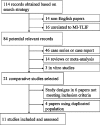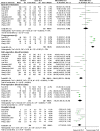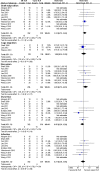Minimally invasive versus open transforaminal lumbar interbody fusion: a meta-analysis based on the current evidence
- PMID: 23572345
- PMCID: PMC3731475
- DOI: 10.1007/s00586-013-2747-z
Minimally invasive versus open transforaminal lumbar interbody fusion: a meta-analysis based on the current evidence
Abstract
Purpose: This is a meta-analysis of randomized and non-randomized studies comparing the clinical and radiological efficacy of minimally invasive (MI) and conventional open transforaminal lumbar interbody fusion (open-TLIF) for degenerative lumbar diseases.
Methods: A literature search of the MEDLINE database identified 11 studies that met our inclusion criteria. A total of 785 patients were examined. Pooled estimates of clinical and radiological outcomes, and corresponding 95% confidence intervals were calculated.
Results: The pooled data revealed that MI-TLIF was associated with less blood loss, shorter hospital stay, and a trend of better functional outcomes when compared with open-TLIF. However, MI-TLIF significantly increased the intraoperative X-ray exposure. Both techniques had similar operative time, complication rate, and re-operation rate.
Conclusions: Based on the available evidence, MI-TLIF for degenerative lumbar diseases might lead to better patient-based outcomes. MI-TLIF would be a promising procedure, but extra efforts are needed to reduce its intraoperative radiation exposure. More randomized controlled trials are needed to compare these two surgical options.
Figures





Comment in
-
Answer to the Letter to the Editor of Feng Li et al. entitled "Minimally invasive versus open transforaminal lumbar interbody fusion: a meta-analysis based on the current evidence" by Nai-Feng Tian, Yao-Sen Wu, Xiao-Lei Zhang, Hua-Zi Xu, Yong-Long Chi, Fang-Min Mao (2013). Eur Spine J, doi:10.1007/s00586-013-2747-z.Eur Spine J. 2014 Apr;23(4):929-30. doi: 10.1007/s00586-014-3185-2. Epub 2014 Jan 18. Eur Spine J. 2014. PMID: 24442185 Free PMC article. No abstract available.
-
Comment on Tian et al.: Minimally invasive versus open transforaminal lumbar interbody fusion: a meta-analysis based on the current evidence.Eur Spine J. 2014 Apr;23(4):927-8. doi: 10.1007/s00586-014-3176-3. Epub 2014 Jan 22. Eur Spine J. 2014. PMID: 24448896 Free PMC article. No abstract available.
References
-
- Wang J, Zhou Y, Zhang ZF, Li CQ, Zheng WJ, Liu J. Minimally invasive or open transforaminal lumbar interbody fusion as revision surgery for patients previously treated by open discectomy and decompression of the lumbar spine. Eur Spine J. 2011;20:623–628. doi: 10.1007/s00586-010-1578-4. - DOI - PMC - PubMed
-
- Foley KT, Holly LT, Schwender JD. Minimally invasive lumbar fusion. Spine. 2003;28:S26–S35. - PubMed
Publication types
MeSH terms
LinkOut - more resources
Full Text Sources
Other Literature Sources
Miscellaneous

